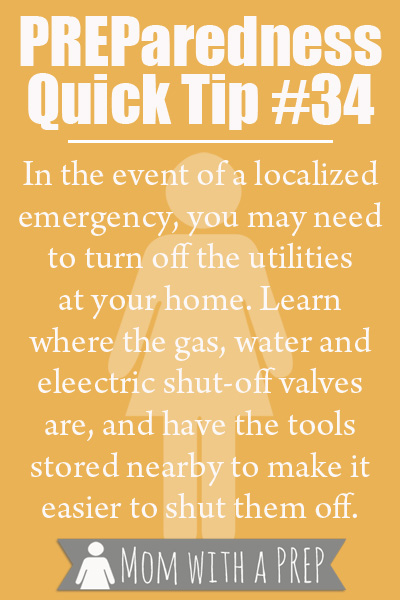
Do you know how to turn off your utilities in the event of an emergency?
One of the things that is handy to know is how to turn off your utilities. Though most utility companies would prefer for you to go through them to do so, in the event of an emergency, you might be instructed or need to do it yourself. So be sure you know where the water, gas and electric shut-off valves are, that you know how to do it, and that you have a handy tool that is easy to grab to do it with.
Don’t bury it deeply in the garage thinking you’ll never need it, though. We keep ours hanging on a peg right inside the garage door for quick access.\
No products found.
This a pry bar, water shut off tool, natural gas cut off tool, and small pick. It was developed by firefighters, and depending on where you get it, for around $10-15, it’s a good tool for an emergency.
Shutting off Natural Gas
Because there are so many different mechanisms of delivering Natural Gas to a home, please contact your provider NOW to find out the proper way of turning off the gas. Natural Gas explosions are also a high risk post-disaster, so if you smell gas or hear the hiss of gas escaping from a line in your house, open a window, then evacuate your family immediate and then call the gas company to report the issue from your cellphone or a neighbor’s house AFTER you’ve evacuated.
** WARNING: DO NOT turn your gas back on, post emergency, until you’ve had the utility crew come out to inspect your lines for safety! **
Shutting Off Electricity
Because downed power lines at your home or other damage can cause electrical wires to be exposed and live, it’s important to know how to turn off the electricity to your home at the breaker box. Usually, these are located on an exterior wall or in a utility closet. Turn off the individual breakers before you turn off the main circuit.
Shutting off Water
Most houses have a valve located outside the home around the foundation or in a utility room that is the main valve to shut off water for the home. Do not use the utility shut-off (usually the meter and valve located near the street in a cement box).
Don’t turn your water back on post-disaster until you’ve gotten the okay from civil authorities, to be assured of safe drinking water.
Remember to be safe, stay safe, and reach out for help if you need it!
Want more PREParedness Quick Tips?
Becky is a wildlife enthusiast and pet and livestock care expert with a diploma in canine nutrition. With over a decade of experience in animal welfare, Becky lends her expertise to Simple Family Preparedness through insightful info about pets, livestock, bee keeping, and the practicalities of homesteading.
Last update on 2024-07-27 at 03:07 / Affiliate links / Images from Amazon Product Advertising API


